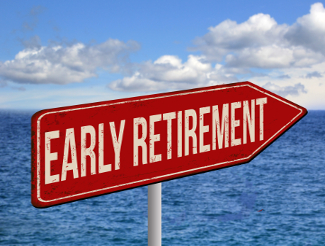The financial press seems to be full of stories of those who have retired early. It’s easy to get jealous when we hear stories of those who have retired in their 30s and who plan on never holding a full-time job again. In many cases when you dig deeper you find that these are people who held nice six-figure jobs, enjoyed generous employer-sponsored 401(k) packages, and who aren’t burdened by expenses that most other people face such as houses and children.
But just because early retirement may not be something that most people can achieve doesn’t mean that there aren’t lessons that can be learned from early retirees. Principles taken from the FIRE movement (Financial Independence, Retire Early) can still be applied to everyone’s lives, enabling them to achieve the financial independence that is so necessary to enjoy a comfortable retirement.
Save Early and Often
It should go without saying that saving is the key to being able to have enough money in retirement. Without the discipline to save money throughout your career and a plan to put those savings to work for you, you can’t expect to have enough money to retire. Depending on Social Security, lottery winnings, or family members isn’t a good enough plan. You and you alone are responsible for your well-being in retirement.
The first principle of saving is to start saving early. The compounding of growth over time means that saving less while starting earlier will leave you with more savings than saving more while starting later.
Someone who starts saving at age 25 and saves and invests $5,000 per year at an annualized growth rate of 6% will have $419,000 at age 55 and $820,000 at age 65. Someone who doesn’t start saving until age 35 and saves $8,000 per year will only have $312,000 at age 55 and $670,000 at age 65.
Even though the person who started saving later saved and invested a larger amount of money in a shorter amount of time ($160,000 in 20 years and $240,000 in 30 years versus $150,000 in 30 years and $200,000 in 40 years), he can’t make up for that lost time. Catching up on lost time requires at least double the savings if you want to match what you would have saved, something that many people just can’t do.
Know How Much You Spend
One problem that many households have in keeping their spending under control is that they don’t know how much they spend. Bills come in, get paid, money goes out, bank accounts fluctuate up and down, but they don’t know exactly how much they are spending or saving each month.
Basic bookkeeping isn’t that hard and can be done in a simple spreadsheet. Just keep a list each month of everything you spend in one column, with a list of all of your income in another column. If you don’t already do this you might be shocked to see just what you’re spending your money on. And if you’ve found it difficult to save money in the past, that first step of figuring out how much you spend is crucial to being able to minimize your expenses going forward.
Minimize Debt and Expenses
Unless you’re receiving raises every month, the only way you can increase your savings is to minimize the amount of money you spend. That means minimizing any debt you carry and only spending money on things that are absolutely necessary like food, housing, and utilities.
Debt is the number one enemy of saving and investment, as interest rate compounding on debt will put you into a hole even quicker than interest compounding on investments will get you rich. Paying down debt should be the first thing you do to get on the path to financial independence. As long as you have the stress of debt hanging over your head it’s going to be difficult to get on the right track with your savings.
Once you have debt minimized, it’s time to start looking at monthly expenses. Cutting back on extraneous little purchases can save hundreds or even thousands of dollars every year, allowing you to put that money towards savings and investment.
Choose Your Investments Wisely
Once you start saving money it becomes necessary to pick the right investments. A strong investment portfolio should provide opportunities for solid growth during good times while protecting against being wiped out during bad times. It should be diversified not just within financial assets but also across different asset classes.
That means at the minimum not just a strong mix of stocks and bonds, but also a significant amount of alternative assets such as gold. Gold has protected investor portfolios for centuries and will continue to do so for centuries into the future. Building up a large investment portfolio is great, but unless you’re willing and able to protect it against a decline in value by hedging with gold, there’s a strong likelihood that you’ll sustain major losses.
However you decide to structure your portfolio, the key is to develop a plan for savings and investment and then execute it. Just because you won’t be retiring early doesn’t mean that you can’t employ the same techniques and strategies as those who are. With disciplined saving and investment, anyone can enjoy the fruits of their labors in retirement.
This article was originally posted on Goldco.





